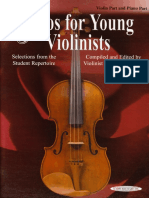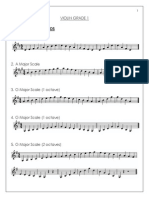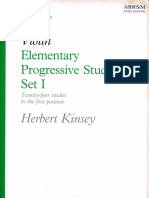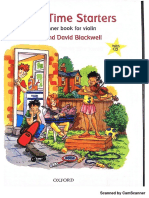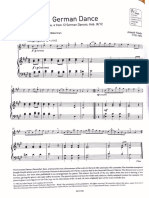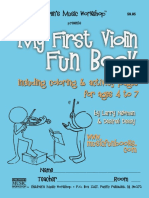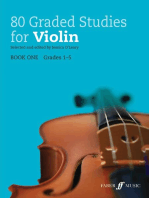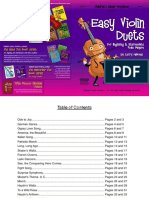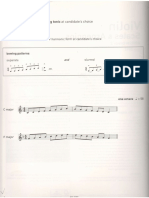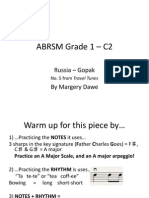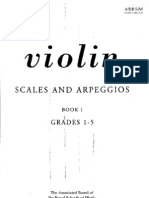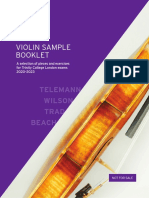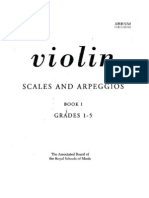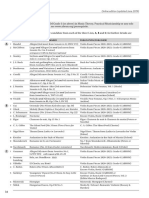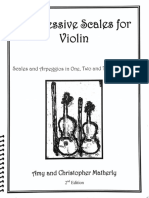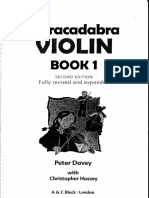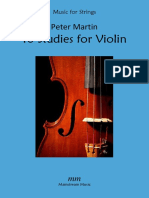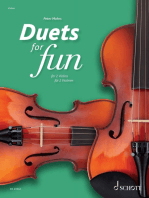Abrsm PDF
Abrsm PDF
Uploaded by
SandmanCopyright:
Available Formats
Abrsm PDF
Abrsm PDF
Uploaded by
SandmanOriginal Description:
Original Title
Copyright
Available Formats
Share this document
Did you find this document useful?
Is this content inappropriate?
Copyright:
Available Formats
Abrsm PDF
Abrsm PDF
Uploaded by
SandmanCopyright:
Available Formats
ABRSM Violin Exams
Here are somekey pointsto help you prepare for your Grade4 exam.All requirements are valid from 1 January 2020 until
31 December2023. More detailed information on the syllabus requirements and syllabus overlap details can be found
online at www.abrsm.org/violin. In the exam, the requirements can be taken in any order.
Pieces (3x 30 marks)
This book contains nine pieces from ABRSM's 2020-2023 Grade4 Violin syllabus. In the exam,
you will need to play three pieces, one from each of the three syllabuslists (A, B and C).
You can choosefrom the piecesin this book and/or the otherpieces setfor the grade: a full list is on the
opposite page. You will needto follow all da capo (D.C.) and dal segno(D.S.) indications but other repeats
(includingfirst-time bars) should not be played unlessthey are very short(i.e. a few bars) or unless the
syllabusspecifies differently.
Scales and arpeggios (21 marks)
Learningscales and arpeggios helps you to build strong technical skills by developingreliable finger
movement, handposition, co-ordination and fingerboardfluency.It also helps you to develop your
musical understanding through familiarity with keys andtheir related patterns.
You can find a complete list of scales and arpeggios required for Grade 4 in the back of this book.In the exam,
they should be played from memory.
Sight-reading (21 marks)
Learningto sight-read helps you to develop quick recognition of keys, tonality and common rhythm
patterns.It also helps you to learn to keep going even when you makemistakes, and work musicoutfor
yourself - which makes learning new pieces quicker andeasier.
In the exam,youwill be askedto play a short unaccompanied piece of music that you have not seen before.
Youwill be given half a minute to look through and,if you wish,try outall or any part of the test before you
are askedtoplayit to the examinerfor assessment.Forthefull sight-reading parameters, please see the
syllabus.
Aural tests (18 marks)
Auralskills enable you to assess the sound andbalanceof yourplaying, keep in time andplay with a sense
of rhythm andpulse. Theseskills also help you to develop yoursenseof pitch, your musical memory and
to spot any mistakes.
In the exam,thetests will be administered by the examinerfrom the piano, and youwill be asked:
a To sing or play from memory a melody played twice by the examiner.
b To sing five notes from scorein free time.
c (i) To answer questions about twofeatures of a piece played by the examiner.
(ii) To clap the rhythm ofthe notesin an extract from the samepiece, andto identify whetherit is in
two time, three time or four time.
For moredetailed information onthetests, please see the syllabus.
(Total available: 150 marks)
Editorial guidance
Wehavetaken the piecesin this book from a variety of sources. Where appropriate, we haveedited the pieces to help
you prepare for your performance. We have added metronome markings(in square brackets) and ornamentrealisations.
The fingering and bowingindications have been amended wherenecessaryto ensure a consistent approachwithin the
album. Details of other changesor suggestionsare given in the footnotes. Fingering, bowing andeditorial additions are for
guidanceonly: you do nothaveto follow them in the exam.
You might also like
- Violin Exam Pieces From 2024, ABRSM Grade 1, Violin PartDocument16 pagesViolin Exam Pieces From 2024, ABRSM Grade 1, Violin Partboblao88% (8)
- Violin Grade 3 Book-1Document17 pagesViolin Grade 3 Book-1Anish Mukherjee85% (26)
- Violin Star 1 PDFDocument34 pagesViolin Star 1 PDFpaula_18_carnefice100% (8)
- Barbara Barber Solos For Young Violinist 4 ViolinDocument21 pagesBarbara Barber Solos For Young Violinist 4 ViolinItam100% (23)
- Exam Pieces Grade 1 ABRSMDocument10 pagesExam Pieces Grade 1 ABRSMAurora del Río100% (5)
- Outside This House - Vanessa (Barber)Document5 pagesOutside This House - Vanessa (Barber)Sandman100% (1)
- Violin Grade 4 (2020-2023)Document21 pagesViolin Grade 4 (2020-2023)fuat80% (5)
- Violin Grade 1Document4 pagesViolin Grade 1malcovishes100% (1)
- Kinsey Violin Set 1 PDFDocument19 pagesKinsey Violin Set 1 PDFTee Tee Jay60% (5)
- ABRSM Violin 2024 OnwardsDocument64 pagesABRSM Violin 2024 OnwardsSayantan DebnathNo ratings yet
- Abracadabra Violin - InglesDocument42 pagesAbracadabra Violin - InglesPerla Romero Álvarez100% (5)
- A Million DreamsDocument10 pagesA Million DreamsLeo WidiNo ratings yet
- Violin Abrsm Grade 4Document1 pageViolin Abrsm Grade 4Hong CeeNo ratings yet
- Eta Cohen Book 3Document121 pagesEta Cohen Book 3jammes100% (2)
- Violin Grade 2Document11 pagesViolin Grade 2nelson_ho_7100% (7)
- Fiddle Time StartersDocument40 pagesFiddle Time StartersIgnasia Soledad Carrillo Muñoz100% (14)
- Violin Finger Patterns WebbDocument21 pagesViolin Finger Patterns WebbProyecto Zaragoza100% (10)
- Grade 3 ViolinDocument6 pagesGrade 3 ViolinDanielCrompton100% (1)
- A Tune A Day Violino 2 PDFDocument42 pagesA Tune A Day Violino 2 PDFmarcosecarla100% (2)
- Keiko Matsui - Be With MeDocument2 pagesKeiko Matsui - Be With MeSusana Liz Vargas100% (6)
- Fiddle Time Sprinters - Revised Verison - Kathy BlackwellDocument4 pagesFiddle Time Sprinters - Revised Verison - Kathy Blackwellpifyfizi15% (13)
- Violinstar 1Document34 pagesViolinstar 1lumilas95% (20)
- MyFirstViolinFunBook PDFDocument34 pagesMyFirstViolinFunBook PDFshuklankita100% (3)
- Essential Scales and Studies For ViolinDocument41 pagesEssential Scales and Studies For ViolinNaz Lek100% (1)
- Fiddle Time Runners - Revised Version: A Second Book of Easy Pieces For Violin - Kathy BlackwellDocument4 pagesFiddle Time Runners - Revised Version: A Second Book of Easy Pieces For Violin - Kathy Blackwellpimutoby0% (7)
- Sample Violin-Duets PDFDocument12 pagesSample Violin-Duets PDFAntonio Carlos100% (2)
- The Doflein Method: The Violinist's Progress. The second and third positionsFrom EverandThe Doflein Method: The Violinist's Progress. The second and third positionsRating: 3.5 out of 5 stars3.5/5 (5)
- The Doflein Method: The Violinist's Progress. The BeginningFrom EverandThe Doflein Method: The Violinist's Progress. The BeginningRating: 5 out of 5 stars5/5 (4)
- The Doflein Method: The Violinist's Progress. Development of technique within the first positionFrom EverandThe Doflein Method: The Violinist's Progress. Development of technique within the first positionRating: 5 out of 5 stars5/5 (2)
- Communicating in The Third SpaceDocument218 pagesCommunicating in The Third SpaceSandman100% (1)
- String Street - ViolinDocument36 pagesString Street - ViolinAmina Salihu100% (6)
- Master Third Position With Finger PatternsDocument162 pagesMaster Third Position With Finger PatternsCradle90% (10)
- ViolinStar Vol2 PDFDocument31 pagesViolinStar Vol2 PDFCBM2014100% (14)
- Grade 2 Violin ScalesDocument7 pagesGrade 2 Violin ScalesFrank Chow100% (1)
- Violin Songs and Hand Shapes 2016Document106 pagesViolin Songs and Hand Shapes 2016Ivan Hockley100% (16)
- ABRSM Violin Grade 1 2012-2015 C2 Russia Gopak PRACTICE NOTESDocument8 pagesABRSM Violin Grade 1 2012-2015 C2 Russia Gopak PRACTICE NOTESEmily Sharratt50% (2)
- CAROL BARRATT - Bravo Violin PDFDocument22 pagesCAROL BARRATT - Bravo Violin PDFBeatriz Alcalde100% (2)
- Abrsm Publishing Violin Scales and Arpeggios Book 1Document12 pagesAbrsm Publishing Violin Scales and Arpeggios Book 1Divaci Diniz Castro100% (1)
- Pokemon RSE - Littleroot Town ThemeDocument2 pagesPokemon RSE - Littleroot Town ThemeMigs030% (1)
- 24 Keys: Scales and Arpeggios for Violin, Book 1From Everand24 Keys: Scales and Arpeggios for Violin, Book 1Rating: 4 out of 5 stars4/5 (7)
- Violin Sample Booklet 2020-2023 PDFDocument21 pagesViolin Sample Booklet 2020-2023 PDFAnh Khoa Nguyen0% (1)
- Escalas Violin ABRSM 1-5 PosterDocument14 pagesEscalas Violin ABRSM 1-5 PosterRomelia Tchanik100% (1)
- Violin Grade Syllabus 06 02Document12 pagesViolin Grade Syllabus 06 02Guido Felipe Sant Anna100% (1)
- ABRSM Strings GuideDocument36 pagesABRSM Strings GuideDaniel Sandi100% (4)
- Grade 6: Sonata No. 3 in E Minor)Document18 pagesGrade 6: Sonata No. 3 in E Minor)BryandhitusNo ratings yet
- Violin Book 1Document34 pagesViolin Book 1tranvu76100% (1)
- Waggon WheelsDocument13 pagesWaggon Wheelsprezeus100% (1)
- A Guide To Teaching Violin To The Very Young Child - Jennie KlimDocument66 pagesA Guide To Teaching Violin To The Very Young Child - Jennie KlimDaryHeuvelman100% (22)
- ABRSM Violin Grade 8 Syllabus, 2011-2013Document2 pagesABRSM Violin Grade 8 Syllabus, 2011-2013Zak Thomas Johnson100% (1)
- Progressive Scales For ViolinDocument72 pagesProgressive Scales For ViolinNaz LekNo ratings yet
- Pathways Through The Violin SyllabusDocument10 pagesPathways Through The Violin SyllabusOsmank100% (2)
- Violin Grade 2 (2016-2019)Document11 pagesViolin Grade 2 (2016-2019)fuatNo ratings yet
- List of Repértorie ViolinDocument96 pagesList of Repértorie ViolinAndres Gallegos67% (3)
- Violin Scales and ArpeggiosDocument12 pagesViolin Scales and ArpeggiosLiliana Mondaca Tagle100% (7)
- ABRSM Violin 2016 SyllabusDocument26 pagesABRSM Violin 2016 SyllabusAlan Chan67% (3)
- Violin BeginnerDocument8 pagesViolin Beginnerdorothée FONTCOUBERTE100% (2)
- Abracadabra Violin PRA DASARDocument42 pagesAbracadabra Violin PRA DASARACIEM ElkemlyNo ratings yet
- Teaching Violin BeginnersDocument7 pagesTeaching Violin BeginnersJessa Mae de Guzman100% (3)
- Bowed StringsDocument83 pagesBowed Stringsjbcmusic7309100% (5)
- 10 Studies For ViolinDocument11 pages10 Studies For Violinjuan pablo martinez100% (3)
- Duets for Fun: for 2 ViolinsFrom EverandDuets for Fun: for 2 ViolinsPeter MohrsRating: 5 out of 5 stars5/5 (2)
- The Doflein Method: The Violinist's Progress. The higher positions (4th to 10th positions)From EverandThe Doflein Method: The Violinist's Progress. The higher positions (4th to 10th positions)Rating: 5 out of 5 stars5/5 (5)
- InternationalJournalofMusicEducation 2015 Rakena 0255761415590365Document15 pagesInternationalJournalofMusicEducation 2015 Rakena 0255761415590365SandmanNo ratings yet
- Premchand On Culture and EducationDocument145 pagesPremchand On Culture and EducationSandmanNo ratings yet
- Deposuit Potentes PDFDocument5 pagesDeposuit Potentes PDFSandmanNo ratings yet
- Capeesh Drinks Menu 2019Document5 pagesCapeesh Drinks Menu 2019SandmanNo ratings yet
- Safeguarding Policy 2020Document37 pagesSafeguarding Policy 2020SandmanNo ratings yet
- Travel RelaxationDocument1 pageTravel RelaxationSandmanNo ratings yet
- Junior Prospectus 2017Document48 pagesJunior Prospectus 2017SandmanNo ratings yet
- 1605272008document Requirement 04112020Document7 pages1605272008document Requirement 04112020SandmanNo ratings yet
- Ride of Tarquinius - Interlude PDFDocument9 pagesRide of Tarquinius - Interlude PDFSandmanNo ratings yet
- Title: Heading 1Document1 pageTitle: Heading 1SandmanNo ratings yet
- Tenor Rape of Lucretia Aria PDFDocument9 pagesTenor Rape of Lucretia Aria PDFSandmanNo ratings yet
- ChoirMasters Burial - BrittenDocument6 pagesChoirMasters Burial - BrittenSandman100% (2)
- Is My Team Ploughing - ButterworthDocument4 pagesIs My Team Ploughing - ButterworthSandman100% (1)
- Pria Che Spunti 1Document6 pagesPria Che Spunti 1SandmanNo ratings yet
- Gia Mi Sembra - La Fedelta Premiata (Haydn) PDFDocument6 pagesGia Mi Sembra - La Fedelta Premiata (Haydn) PDFSandmanNo ratings yet
- O Wie Ängstlich - MozartDocument5 pagesO Wie Ängstlich - MozartSandmanNo ratings yet
- Rebecca Clarke PDFDocument6 pagesRebecca Clarke PDFSandmanNo ratings yet
- (G) I Dle WikipediaDocument128 pages(G) I Dle WikipediaEl LeeNo ratings yet
- Demanda Contra Exponentes Del Género UrbanoDocument82 pagesDemanda Contra Exponentes Del Género UrbanoMetro Puerto RicoNo ratings yet
- Amendment EssayDocument61 pagesAmendment Essayozvvfacaf100% (2)
- Hooverphonic Biography (2000)Document4 pagesHooverphonic Biography (2000)6980MulhollandDriveNo ratings yet
- EJERCICIO TEMA 1 PARTE 1 OPERATORIA DE TECLADOS. Paola SánchezDocument9 pagesEJERCICIO TEMA 1 PARTE 1 OPERATORIA DE TECLADOS. Paola SánchezPaolaNo ratings yet
- Translators Note T. PadmanabhanDocument15 pagesTranslators Note T. PadmanabhanAnjanaSankarNo ratings yet
- Chromatic Chords - FlowchartDocument9 pagesChromatic Chords - FlowchartMattiaNo ratings yet
- Kartu Soal PKN SMP 17 RevisiDocument42 pagesKartu Soal PKN SMP 17 RevisiANNA NURAULIAHNo ratings yet
- 2019 Term 3 Scheme BookDocument44 pages2019 Term 3 Scheme BookMbikomuhle NdebeleNo ratings yet
- Dokumen - Pub - Sound Effect The Theatre We Hear 9781350045903 9781350045934 9781350045927Document241 pagesDokumen - Pub - Sound Effect The Theatre We Hear 9781350045903 9781350045934 9781350045927Saka Nur AlfiansyahNo ratings yet
- Quiet Night DrumsDocument4 pagesQuiet Night DrumsShin-HNo ratings yet
- Star-Light-Zone-Sonic-The-Hedgehog-Tabs Jmmy On GuitarDocument2 pagesStar-Light-Zone-Sonic-The-Hedgehog-Tabs Jmmy On Guitarandre luizNo ratings yet
- GE 6: PIKNIK Discussion: Manilac Lay Labi From Pahilaga. Composed by R. CayabyabDocument1 pageGE 6: PIKNIK Discussion: Manilac Lay Labi From Pahilaga. Composed by R. CayabyabNeølie Abello LatúrnasNo ratings yet
- Hino NacionalDocument4 pagesHino NacionalRonaldbrzNo ratings yet
- I. Somone Like Him II. Medicate (Awakening)Document31 pagesI. Somone Like Him II. Medicate (Awakening)AnderzxonNo ratings yet
- Daily Life and Social CustomsDocument8 pagesDaily Life and Social CustomserokuNo ratings yet
- Lana Del Rey - Summertime SadnessDocument7 pagesLana Del Rey - Summertime SadnessTonijssNo ratings yet
- Im A Believer Shrek - Smash Mouth - CoralDocument2 pagesIm A Believer Shrek - Smash Mouth - CoralPriscila BarrosNo ratings yet
- Jason Becker Sweep LickDocument1 pageJason Becker Sweep LicksmurfqlranciaNo ratings yet
- Whither Must I Wander Soprano 2 & Tenor 1Document2 pagesWhither Must I Wander Soprano 2 & Tenor 1bunnyhop9No ratings yet
- Los Tiliches Banda Aires Del PacíficoDocument14 pagesLos Tiliches Banda Aires Del PacíficoJohn Santiago100% (3)
- Trends, Networks, and Critical Thinking in The 21 Century CultureDocument2 pagesTrends, Networks, and Critical Thinking in The 21 Century CultureYhel LantionNo ratings yet
- Lithuanian Passages in Music and Life of PDFDocument14 pagesLithuanian Passages in Music and Life of PDFGreta BeleškaitėNo ratings yet
- NEMusicPub - NMP Grading SystemDocument3 pagesNEMusicPub - NMP Grading SystemMiika HyytiäinenNo ratings yet
- Somewhere Over The Rainbow-Partitura y PartesDocument6 pagesSomewhere Over The Rainbow-Partitura y PartesOCFA OficialNo ratings yet
- Folk Song and The ConstructionDocument388 pagesFolk Song and The ConstructionSasha PozelliNo ratings yet
- Adam Rafferty - Silent Night - Lesson PDFDocument25 pagesAdam Rafferty - Silent Night - Lesson PDFHarry Jones100% (1)



